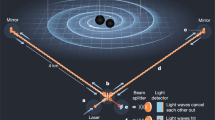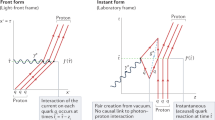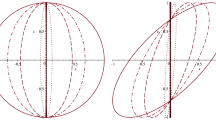Abstract
The recent discovery of gravitational waves is often seen as the confirmation of a prediction Einstein made one century ago. We argue instead that only after conceptual advances in general relativity between the mid-1950s and the early 1960s could such a prediction be made on the basis of unambiguous notions shared by a community of specialists. The conceptual transformation and the reorganization of knowledge related to general relativity that characterized this post-Second World War period can be used to properly understand the hitherto vaguely defined ‘renaissance of general relativity’. During its first phase, theoreticians took a conservative turn by refocusing on general relativity, after previously having worked on other research agendas mostly targeted at substituting general relativity with a superior theory. This turn was followed by a second phase that was characterized by a plurality of approaches to general relativity, which had in common the fact that they were able to develop intrinsically (generally) relativistic concepts, in particular radiation, rather than using other theories as an interpretative crutch.
This is a preview of subscription content, access via your institution
Access options
Access Nature and 54 other Nature Portfolio journals
Get Nature+, our best-value online-access subscription
$29.99 / 30 days
cancel any time
Subscribe to this journal
Receive 12 digital issues and online access to articles
$119.00 per year
only $9.92 per issue
Buy this article
- Purchase on Springer Link
- Instant access to full article PDF
Prices may be subject to local taxes which are calculated during checkout





Similar content being viewed by others
References
Abbott, B. P. et al. (LIGO Scientific Collaboration and Virgo Collaboration) Observation of gravitational waves from a binary black hole merger. Phys. Rev. Lett. 116, 061102 (2016).
Siegel, E. Gravitational waves: from discovery of the year to science of the century. Forbes (27 December 2016); https://go.nature.com/2jvKjRb
Einstein, A. Näherungsweise Integration der Feldgleichungen der Gravitation. Sitzber. K. Preuss. Aka. 688–696 (1916).
Kramer, D. Gravitational waves are detected for first time. Phys. Today (12 February 2016); https://go.nature.com/2JSa0qi
Will, C. M. Was Einstein Right?: Putting General Relativity to the Test. (Basic Books, New York, 1986).
Kennefick, D. Traveling at the Speed of Thought: Einstein and the Quest for Gravitational Waves (Princeton University Press, Princeton, 2007).
Renn, J., Wintergrün, D., Lalli, R., Laubichler, M. & Valleriani, M. in Die Zukunft der Wissensspeicher : Forschen, Sammeln und Vermitteln im 21. Jahrhundert (eds Mittelstraß, J. & Rüdiger, U.) 35–79 (UVK Verlagsgesellschaft, 2016).
Renn, J. in The Genesis of General Relativity (ed. Renn, J.) 1229–1255 (Springer, Berlin, 2007).
Schwarzschild to Sommerfeld, 17 February 1916. Deutsches Museum Archiv NL 89, 059.
Einstein to Schwarzschild, 19 February 1916 in The Collected Papers of Albert Einstein. Volume 8: The Berlin Years, 1914–1918 (English Supplement) (eds Schulmann, R. et al.) 196 (Princeton University Press, 1998).
Einstein, A. Über Gravitationswellen. Sitzber. K. Preuss. Aka. 154–167 (1918).
Einstein, A. & Rosen, N. On gravitational waves. J. Frankl. Inst. 223, 43–54 (1937).
Kennefick, D. Einstein versus the Physical Review. Phys. Today 58, 43–48 (2005).
Einstein, A. The Meaning of Relativity 4th edn (Princeton University Press, Princeton, 1953).
Rosen, N. Plane polarised waves in the general theory of relativity. Phys. Z. Sowjetunion 12, 366–372 (1937).
Infeld, L. Equations of motion and gravitational radiation. Ann. Phys. New York 6, 341–367 (1959).
Bondi, H. Plane gravitational waves in general relativity. Nature 179, 1072–1073 (1957).
DeWitt-Morette, C. & Rickles, D. (eds) The Role of Gravitation in Physics: Report from the 1957 Chapel Hill Conference (Edition Open Access, Berlin, 2011).
McVittie, G. C. Gravitational waves and one-dimensional Einsteinian gas-dynamics. J. Ration. Mech. Anal. 4, 201–220 (1955).
Taub, A. H. Empty space–times admitting a three parameter group of motions. Ann. Math. 58, 472–490 (1951).
Will, C. M. The renaissance of general relativity. In The New Physics (ed. Davies, P.) 7–33 (Cambridge University Press, 1989).
Eisenstaedt, J. La relativité générale à l’étiage: 1925–1955. Arch. Hist. Exact Sci. 35, 115–185 (1986).
Eisenstaedt, J. The low water mark of general relativity, 1925–1955. In Einstein and the History of General Relativity (eds Howard, D. & Stachel, J.) 1–277 (Birkhäuser, 1989).
Goenner, H. A golden age of general relativity? Some remarks on the history of general relativity. Gen. Relat. Gravit. 49, 42 (2017).
Thorne, K. S. Black Holes and Time Warps: Einstein’s Outrageous Legacy (W. W. Norton, New York, 1994).
Kaiser, D. I. Making Theory: I. Producing Physics and Physicists in Postwar America. II. Post-inflation Reheating in an Expanding Universe PhD Thesis, Harvard Univ. (2000).
Blum, A., Giulini, D., Lalli, R. & Renn, J. Editorial introduction to the special issue “The Renaissance of Einstein’s Theory of Gravitation”. Eur. Phys. J. H 42, 95–105 (2017).
Kaiser, D. & Rickles, D. The price of gravity: Private patronage and the transformation of gravitational physics after World War II. Hist. Stud. Nat. Sci. 48, 338–379 (2018).
Blum, A., Lalli, R. & Renn, J. The reinvention of general relativity: A historiographical framework for assessing one hundred years of curved space–time. Isis 106, 598–620 (2015).
Blum, A. S., Lalli, R. & Renn, J. The renaissance of general relativity: How and why it happened. Ann. Phys. 528, 344–349 (2016).
Kennefick, D. Not only because of theory: Dyson, Eddington, and the competing myths of the 1919 Eclipse Expedition. In Einstein and the Changing Worldviews of Physics (eds Lehner, C., Renn, J. & Schemmel, M.) 201–232 (Birkhäuser, Boston, 2012).
Blum, A., Gavroglu, K., Joas, C. & Renn, J. Shifting Paradigms: Thomas. S. Kuhn and the History of Science (Edition Open Access, 2016).
Kuhn, T. S. The Road Since Structure (eds Conant, J. & Haugelan, J.) (Univ. Chicago Press, Chicago, 2000).
Kuhn, T. S. The Structure of Scientific Revolutions. 10–11 (Univ. Chicago Press, Chicago, 1970).
Gutfreund, H. & Renn, J. The Formative Years of Relativity: The History and Meaning of Einstein’s Princeton Lectures (Princeton Univ. Press, Princeton, 2017).
Goldstein, C. & Ritter J. The varieties of unities: Sounding unified theories 1920–1930. In Revisiting the Foundations of Relativistic Physics: Festschrift in Honor of John Stachel (eds Ashtekar, A. et al.) 93–149 (Springer Netherlands, Dordrecht, 2003).
Goenner, H. F. M. On the history of unified field theories. Living Rev. Relativ. 7, 2 (2004).
Oppenheimer, J. R. & Volkoff, G. M. On massive neutron cores. Phys. Rev. 55, 374–381 (1939).
Oppenheimer, J. R. & Snyder, H. On continued gravitational contraction. Phys. Rev. 56, 455–459 (1939).
Ortega-Rodríguez, M. et al. The early scientific contributions of J. Robert Oppenheimer: Why did the scientific community miss the black hole opportunity? Phys. Perspect. 19, 60–75 (2017).
Brinkmann, H. W. Einstein spaces which are mapped conformally on each other. Math. Ann. 94, 119–145 (1925).
Beck, G. Zur theorie binärer gravitationsfelder. Z. Phys. A 33, 713–728 (1925).
Baldwin, O. R. & Jeffery, G. B. The relativity theory of plane waves. Proc. R. Soc. Lond. A 111, 95–104 (1926).
Kaiser, D. Booms, busts, and the world of ideas: Enrollment pressures and the challenge of specialization. Osiris 27, 276–302 (2012).
Kaiser, D. Drawing Theories Apart: The Dispersion of Feynman Diagrams in Postwar Physics (Univ. Chicago Press, Chicago, 2005).
Mercier, A. & Kervaire, M. Fünfzig Jahre Relativitätstheorie, Verhandlungen — Cinquantenaire de la Théorie de la Relativité, Actes — Jubilee of Relativity Theory, Proceedings (eds Mercier. A. & Kervaire, M.) (Birkhäuser, 1956).
Lalli, R. Building the General Relativity and Gravitation Community During the Cold War (Springer, Berlin,2017).
Bettencourt, L. M. A., Kaiser, D. I., Kaur, J., Castillo-Chávez, C. & Wojick, D. E. Population modeling of the emergence and development of scientific fields. Scientometrics 75, 495–518 (2008).
Pauli, W. 1956. Schlußwort den Präsidenten der Konferenz. In Fünfzig Jahre Relativitätstheorie, Verhandlungen — Cinquantenaire de la Théorie de la Relativité, Actes — Jubilee of Relativity Theory, Proceedings (eds Mercier. A. & Kervaire, M.) 261–267 (Birkhäuser, 1956).
Bergmann, P. G. Fifty years of relativity. Science 123, 486–494 (1956).
John Archibald Wheeler Papers Box 182, Folder ‘Fields and Particles’ (American Philosophical Society, 1954).
Rosen, N. Gravitational waves. In Fünfzig Jahre Relativitätstheorie, Verhandlungen — Cinquantenaire de la Théorie de la Relativité, Actes — Jubilee of Relativity Theory, Proceedings (eds Mercier. A. & Kervaire, M.) 171–175 (Birkhäuser, 1956).
Pauli to Fierz, 21 February 1956. in Wolfgang Pauli — Scientific Correspondence with Bohr, Einstein, Heisenberg, a.o., Volume IV, Part III: 1955–1956 (ed. von Meyenn, K.) 492–495 (Springer, Berlin, 2001).
Fierz to Pauli, 24 September 1954. in Wolfgang Pauli — Scientific Correspondence with Bohr, Einstein, Heisenberg, a.o., Volume IV, Part II: 1953–1954 (ed. von Meyenn, K.) 762–763 (Springer, Berlin, 1999).
Fierz to Pauli, 29 September 1954. in Wolfgang Pauli — Scientific Correspondence with Bohr, Einstein, Heisenberg, a.o., Volume IV, Part II: 1953–1954 (ed. von Meyenn, K.) 770–771 (Springer, Berlin, 1999).
Bondi, H. Science, Churchill, and Me: The Autobiography of Hermann Bondi, Master of Churchill College, Cambridge 79 (Pergamon, Oxford, 1990).
Interview with Felix Pirani by Dean Rickles, 23 June 2011 (Niels Bohr Library & Archives, American Institute of Physics, 2011); https://go.nature.com/2juxgje
Pirani, F. A. E. & Schild, A. On the quantization of Einstein’s gravitational field equations. Phys. Rev. 79, 986–991 (1950).
Synge, J. L. Relativity: The Special Theory (North-Holland, Amsterdam, 1956).
Alfred Schild Papers 1915–1982 Box 86–27/1, Pirani to Schild undated letter (Briscoe Center for American History, 1956).
Rosen, N. Energy and momentum of cylindrical gravitational waves. Phys. Rev. 110, 291–292 (1958).
Schilling, G. Ripples in Spacetime: Einstein, Gravitational Waves, and the Future of Astronomy (Harvard University Press, Cambridge, 2017).
Pirani, F. A. E. Invariant formulation of gravitational radiation theory. Phys. Rev. 105, 1089–1099 (1957).
Petrov, A. Z. Classification of spaces defining gravitational fields. Proc. Kazan Univ. Phys. Math. Ser. 114, 55–69 (1954).
Pirani, F. A. E. On the physical significance of the Riemann tensor. Acta Phys. Pol. 15, 389–405 (1956).
Synge, J. L. On the deviation of geodesics and null-geodesics, particularly in relation to the properties of spaces of constant curvature and indefinite line-element. Ann. Math. 35, 705–713 (1934).
Pirani, F. A. E. Measurement of classical gravitational fields. In The Role of Gravitation in Physics: Report from the 1957 Chapel Hill Conference (eds DeWitt-Morette, C. & Rickles, D.) 141–142 (Edition Open Access, 2011).
Bondi, H. Plane gravitational waves in general relativity. Nature 179, 1072–1073 (1957).
Saulson, P. R. Josh Goldberg and the physical reality of gravitational waves. Gen. Relat. Gravit. 43, 3289–3299 (2011).
Bondi, H., Pirani, F. A. E. & Robinson, I. Gravitational waves in general relativity. III. Exact plane waves. Proc. R. Soc. Lon. Ser. A 251, 519–533 (1959).
Trautman, A. Boundary conditions at infinity for physical theories. Bull. Acad. Polon. Sci. 403–406 (2016); available at https://arxiv.org/abs/1604.03144
Trautman, A. Radiation and boundary conditions in the theory of gravitation. Bull. Acad. Polon. Sci. 407–412 (1958); available at https://arxiv.org/abs/1604.03145
Trautman, A. Lectures on general relativity. Gen. Relat. Gravit. 34, 721–762 (2002).
Hill, C. D. & Nurowski, P. How the green light was given for gravitational wave search. Not. Am. Math. Soc. 64, 686–692 (2017).
Arnowitt, R., Deser, S. & Misner, C. W. Energy and the criteria for radiation in general relativity. Phys. Rev. 118, 1100–1104 (1960).
Bondi, H., van der Burg, M. G. J. & Metzner, A. W. K. Gravitational waves in general relativity. VII. Waves from axi-symmetric isolated systems. Proc. R. Soc. Lond. Ser. A 269, 21–52 (1962).
Sachs, R. Asymptotic symmetries in gravitational theory. Phys. Rev. 128, 2851–2864 (1962).
Newman, E. & Penrose, R. An approach to gravitational radiation by a method of spin coefficients. J. Math. Phys. 3, 566–578 (1962).
Thorne, K. S. & Campolattaro, A. Non-radial pulsation of general-relativistic stellar models. I. Analytic analysis for L >= 2. Astrophys. J. 149, 591–611 (1967).
Price, R. & Thorne, K. S. Non-radial pulsation of general-relativistic stellar models. II. Properties of the gravitational waves. Astrophys. J. 155, 163–182 (1969).
Schutz, B. F. Thoughts about a conceptual framework for relativistic gravity. In Einstein and the Changing Worldviews of Physics (eds Lehner, C., Renn, J. & Schemmel, M.) 259–269 (Birkhäuser, Boston, 2012).
Collins, H. Gravity’s Shadow: The Search for Gravitational Waves (Univ. Chicago Press, Chicago, 2004).
Trimble, V. Wired by Weber. Eur. Phys. J. H 42, 261–291 (2017).
Weber, J. On the possibility of detection and generation of gravitational waves. In Les Théories Relativistes de la Gravitation (eds Licherowicz, A. & Tonnelat M.-A.) 441–450 (Éd. du Centre National de la Recherche Scientifique, 1962).
Bondi, H. On the physical characteristics of gravitational waves. In Les Théories Relativistes de la Gravitation (eds Licherowicz, A. & Tonnelat M.-A.) 129–135 (Éd. du Centre National de la Recherche Scientifique, 1962).
Weber, J. Evidence for discovery of gravitational radiation. Phys. Rev. Lett. 22, 1320–1324 (1969).
Schmidt, M. 3C 273: A star-like object with large red-shift. Nature 197, 1040–1040 (1963).
Penzias, A. A. & Wilson, R. W. A measurement of excess antenna temperature at 4080 Mc/s. Astrophys. J. 142, 419–421 (1965).
Hewish, A., Bell, S. J., Pilkington, J. D. H., Scott, P. F. & Collins, R. A. Observation of a rapidly pulsating radio source. Nature 217, 709–713 (1968).
Robinson, I., Schild, A. & Schucking, E. Quasi-Stellar Sources and Gravitational Collapse, Including the Proceedings of the First Texas Symposium on Relativistic Astrophysics (Univ. Chicago Press, Chicago, 1965).
Hulse, R. A. & Taylor, J. H. Discovery of a pulsar in a binary system. Astrophys. J. Lett. 195, L51–L53 (1975).
Taylor, J. H. & Weisberg, J. M. A new test of general relativity — Gravitational radiation and the binary pulsar PSR 1913+16. Astrophys. J. 253, 908–920 (1982).
Kennefick, D. The binary pulsar and the quadrupole formula controversy. Eur. Phys. J. H 42, 293–310 (2017).
Choptuik, M. W., Lehner, L. & Pretorius, F. Probing strong field gravity through numerical simulations. In General Relativity and Gravitation: A Centennial Perspective (eds Ashtekar, A., Berger, B. K., Isenberg, J. & MacCallum, M.) 361–411 (Cambridge Univ. Press, Cambridge, 2015).
Collins, H. M. Gravity’s Kiss: The Detection of Gravitational Waves (MIT Press, Cambridge, 2017).
Lichnerowicz, A. Théories Relativistes de la Gravitation et de l’Électromagnétisme; Relativité Générale et Théories Unitaires (Masson, Paris, 1955).
Fourès-Bruhat, Y. Théorème d’existence pour certains systèmes d’équations aux dérivées partielles non linéaires. Acta Math. 88, 141–225 (1952).
Arnowitt, R., Deser, S. & Misner, C. W. The dynamics of general relativity. In Gravitation: An Introduction to Current Research (ed. Witten, L.) 227–265 (John Wiley & Sons, New York, 1962).
Hahn, S. G. & Lindquist, R. W. The two-body problem in geometrodynamics. Ann. Phys. 29, 304–331 (1964).
Smarr, L. L. The Structure of General Relativity with a Numerical Illustration: The Collision of Two Black Holes PhD Thesis, Texas Univ. (1975).
DeWitt-Morette, C. The Pursuit of Quantum Gravity: Memoirs of Bryce DeWitt from 1946 to 2004 (Springer,Berlin, 2011).
Misner, C. W. John Wheeler and the recertification of general relativity as true physics. In General Relativity and John Archibald Wheeler (eds Ciufolini, I. & Matzner, R. A.) 9–27 (Springer, Berlin, 2010).
Kaiser, D. Cold War Curvature: Measuring and Modeling Gravitational Systems in Postwar American Physics (2015); https://go.nature.com/2jvWhui
Blum, A. & Hartz, T. The 1957 quantum gravity meeting in Copenhagen: An analysis of Bryce S. DeWitt’s report. Eur. Phys. J. H 42, 107–157 (2017).
Smarr, L. et al. A Center for Scientific and Engineering Supercomputing (National Science Foundation, 1983); https://go.nature.com/2wcRMht
Damerow, P., Freudenthal, G., McLaughlin, P. & Renn, J. Exploring the Limits of Preclassical Mechanics (Springer, Berlin, 1992).
Lefèvre, W. Die Entstehung der biologischen Evolutionstheorie (Suhrkamp, Berlin, 2009).
Klein, U. A revolution that never happened. Stud. Hist. Philos. Sci. A 49, 80–90 (2015).
Feldhay, R., Raqep, F. J. (eds). Before Copernicus: The Cultures and Contexts of Scientific Learning in the Fifteenth Century (McGill-Queen’s University Press, Kingston, 2017).
Renn, J. The Evolution of Knowledge: Toward a Historical Theory of Human Thinking (Princeton Univ. Press, Princeton, in the press).
Weidmann, N. B., Kuse, D. & Gleditsch, K. S. The geography of the international system: The CShapes dataset. Int. Interact. 36, 86–106 (2010).
Brandes, U. & Wagner, D. Visone — Analysis and visualization of social networks. In Graph Drawing Software (eds Jünger, M. & Mutzel P.) 321–340 (Springer, Berlin, 2004).
Chen, C. Turning Points (Springer, Berlin, 2012).
Waltman, L. & van Eck, N. J. A smart local moving algorithm for large-scale modularity-based community detection. Eur. Phys. J. B 86, 471 (2013).
Shannon, P. et al. Cytoscape: a software environment for integrated models of biomolecular interaction networks. Genome Res. 13, 2498–2504 (2003).
Acknowledgements
We are grateful to D. Wintergrün for support in the network analyses and visualizations and F. Kräutli for the visual representation of the research centres.
Author information
Authors and Affiliations
Contributions
A.B., R.L. and J.R. elaborated the historical narrative and wrote the paper. R.L. provided the network analysis.
Corresponding author
Ethics declarations
Competing interests
The authors declare no competing interests.
Additional information
Publisher’s note: Springer Nature remains neutral with regard to jurisdictional claims in published maps and institutional affiliations.
Rights and permissions
About this article
Cite this article
Blum, A., Lalli, R. & Renn, J. Gravitational waves and the long relativity revolution. Nat Astron 2, 534–543 (2018). https://doi.org/10.1038/s41550-018-0472-6
Received:
Accepted:
Published:
Issue Date:
DOI: https://doi.org/10.1038/s41550-018-0472-6
This article is cited by
-
Einstein’s second-biggest blunder: the mistake in the 1936 gravitational-wave manuscript of Albert Einstein and Nathan Rosen
Archive for History of Exact Sciences (2022)
-
The dynamics of collaboration networks and the history of general relativity, 1925–1970
Scientometrics (2020)
-
Historical Networks in Science Education
Science & Education (2020)



